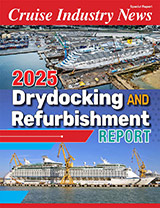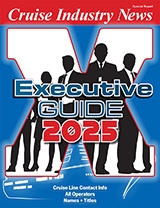Carnival Cruise Lines reported increased third quarter earnings in spite of reduced revenues for the period ended August 31, 1992.
Carnival reported income from continuing operations of $134.8 million and net income of $129.6 million on revenues of $487.8 million compared to income from continuing operations of $130.5 million and net income of $123.1 million on revenues of $499.2 million for the same quarter in 1991.
A spokesperson for Carnival attributed the increased net earnings to better budgeting controls and decreased interest expense. He said that “going into 1992, we would have no new capacity, which traditionally boosts earnings, thus we had to look at other means to increase yield.”
During the third quarter, the company also took an extraordinary charge of $5.2 million in connection with the early redemption of its zero coupon convertible notes.
Carnival attributed the decline in revenue to a decrease in cruise operating days resulting from cancelled cruises caused by Hurricane Andrew and a minor mechanical problem with the Carnivale which led to cancellation of two four-day cruises.
Nine months
For the nine months ended August 31, 1992, income from continuing operations was $238.6 million and net income was $233.4 million on revenues of $1.16 billion compared to income from continuing operations of $215.1 million and net income of $197 million on revenues of $1.10 billion for the same period in 1991. The increase in income was atributed primarily to the additional capacity provided by the Ecstasy.
Net income for the nine months ended August 31, 1992, was 20.9 percent of revenues compared to 17.9 percent in 1991.
Carnival’s quarterly reports also show the seasonal fluctuations of its fleet. For its fiscal 1992, quarterly revenues increased from $328 million in the first quarter to $346 million in the second quarter and $487.8 million in the third quarter. The third quarter performance is largely attributed to Holland America Line’s Alaska season. In 1992 HAL’s Alaska capacity was estimated at 91,000 passengers, up 4,000 from 1991.
For the three months ended August 31, 1992, Carnival achieved an average occupancy level of 114.7 percent carrying 324,650 passengers compared to 328,129 passengers for an average occupancy level of 113.7 percent for the third quarter of 1991.
According to Carnival, the decline in passenger counts in its third quarter of this year was due to reduced capacity available during the third quarter resulting from cancelled sailings.
For the first nine months, fleetwide occupancy level was 106.8 percent compared to 107.2 percent for the same period in 1991.
Passenger counts for the nine months rose 6.5 percent to 891,772 up from 837,275 passengers for the first nine months of 1991.
Forecast
Many analysts reduced their earnings forecast for the near term due to the virtual shutdown of cruise reservations for the week following Hurricane Andrew; anticipated reduced ability to top-off load factors on near term sailings with local cruise passengers; and the additional expenses to fund employee dislocation and hardships. In addition, the publicity surrounding the severe destruction caused by the hurricane in the Miami area is also expected to have an adverse impact on cruise bookings in the fourth quarter.
Long term, most analysts are quite positive. Carnival’s operating history since 1987 shows how added capacity has boosted passenger counts along with revenues and net income.
Thus, Carnival can be expected to post increased earnings with the introduction of new ships through 1995:
1992/93: Holland America Line’s 1,250-passenger Statendam will be introduced late in 1992.
1993/94: Carnival Cruise Line’s 2,044-passenger Sensation will be introduced late in 1993 along with another new ship for HAL, the 1,250-passenger Maasdam.
1994: Carnival will introduce the 2,044-passenger Fascination and HAL will introduce the 1,250-passenger Ryndam.
1995: Carnival will introduce the 2,044-passenger Imagination.
At press time, Carnival shares traded for $26.50 compared to a 12-month high/low of $34/$21.50.



